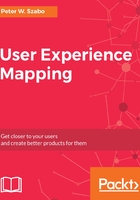
Events (tasks)
Arranging the cards alongside the narrative flow could be a challenge. To help with that, each column of the narrative flow will be an event. Each event will contain one or more user story. Remember, user stories are atomic solutions, and we tried hard to make them as small as possible for a given project. For our web store shipping is an event. The user needs to enter their shipping details. One user story is: I'd like to enter my address (manually). Another user story is: I'd like to enter my postcode, then select my address from the possible addresses on the given postcode. A third one is: I'd like to select the shipping method.
Many authors, including Alistair Cockburn and Jeff Patton, use the term tasks for what I call events. The problem with that term is that it leads to misunderstandings because planning the creation of a product means creating development and testing tasks for your team. Moreover, they are not always tasks in the most common sense of the word, as in a piece of work to be done. Events can be simple thoughts that cross the user’s mind or as complex as viewing the home page for the first time. Usually, events can be associated with things happening while the user interacts with the site. For example, in some turn-based card games, for example, Hearthstone, observing the opponent's turn is certainly an event, but it would be a bit odd to call it a task, as the player can't actively play until it's their turn.
It's often not possible to tell the order of events. For example, we can start our activities in the webshop by searching for the desired product, or by browsing the site, going from categories to subcategories to products. It's also possible that we start with one method, then switch to another. Please remember that the order of cards is the order of the narrative flow, the order in which we will tell the story, not necessarily the order in which the user might perform their actions. However, it certainly makes sense to align the narrative flow with the user's anticipated actions as much as possible.